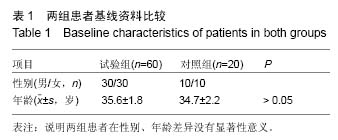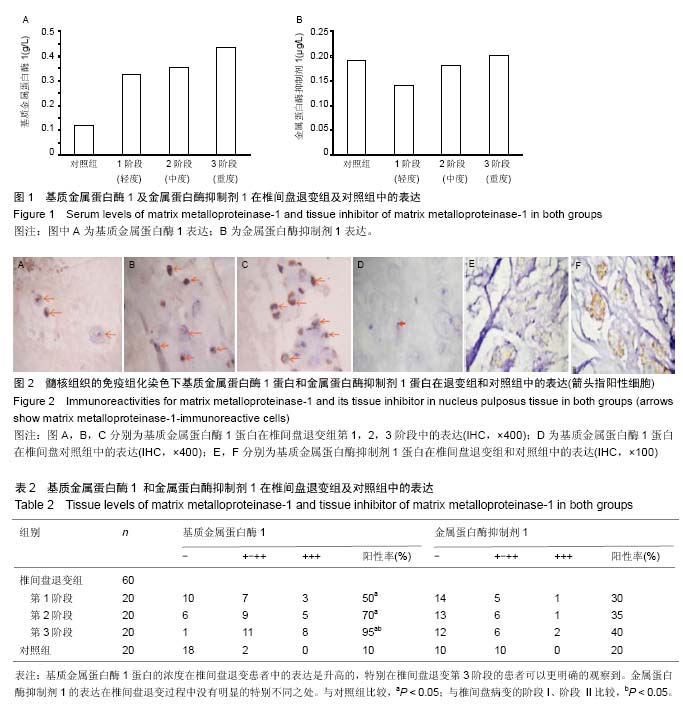| [1] Baliga S,Treon K,Craig NJ.Low Back Pain: Current Surgical Approaches. Asian Spine J. 2015;9(4): 645-657.
[2] 黄庆华.椎间盘退变分子机制的研究进展[J].医学信息(中旬刊).2011,24(4):1672-1674.
[3] Lotz JC,Colliou OK,Chin JR,et al. Compression- induced changes in intervertebral disc properties in a rat tail model.Spine.1999;24:996-1002.
[4] Rastogi A, Kim H, Twomey JD, et al.MMP-2 mediates local degradation and remodeling of collagen by annulus fibrosus cells of the intervertebral disc. Arthritis Res Ther.2013;15(2):R57.
[5] Leung VY, Tam V, Chan D, et al.Tissue engineering for intervertebral disk degeneration. Orthop Clin North Am. 2011;42(4): 575-583.
[6] Hulboy DL,Rudolph LA,Mamsian LM. Metalloproteinase as mediators of reproductive functionI.Mol Hum Reprod.1997;3:27-45.
[7] Baillet A,Grange L,Trocmé C,et al.Differences in MMPs and TIMP-1 expression between intervertebral disc and disc herniation. Joint Bone Spine.2013;80(3): 341-342.
[8] Zou J,Huang GF,Zhang Q,et al.Effects of electroacupuncture stimulation of "Jiaji" (EX-B 2) on expression of matrix metalloproteinase-13 and tissue inhibitor of metalloproteinase-1 in intervertebral disc tissue in rabbits with lumbar intervertebral disc degeneration. Zhen Ci Yan Jiu. 2014;39(3): 192-197.
[9] Gruber HE, Hoelscher GL,Ingram JA,et al.Matrix metalloproteinase-26, a novel MMP, is constitutively expressed in the human intervertebral disc in vivo and in vitro. Exp Mol Pathol.2012;92(1):59-63.
[10] 刘海心,王德春,胡有谷.椎间盘的营养与退变[J].中国矫形外科杂志,2006,14(1):863.
[11] 李小川,李雷.Fas/FasL基因在退变腰椎间盘组织中的表达及诱导凋亡作用[J].中华医学杂志,2005,25(24):1718.
[12] 王守丰,邱勇.生物力学因素对椎体生长板的影响和临床意义[J].中国脊柱脊髓杂志,2006,16(4):301.
[13] Hatano E, Fujita T, Ueda Y, et al. Expression of ADAMTS-4 (aggrecanase-1) and Possible Involvement in Regression of Lumbar Disc Herniation. Spine.2006;31(13):1426.
[14] 王湘达,陈伯华.Ⅳ型胶原在退变椎间盘中的表达及意义[J].青岛大学医学院学报,2003,39(3):318.
[15] Zetser A, Bashenko Y, Miao HQ,et al. Heparanase effects adhesive and tumorigenic potential of human glioma cells. Cancer Res. 2003;63(22):7733-7741.
[16] Wu WP,Jiang JM, Qu DB,et al.Expression of hypoxia-inducible factor-1alpha and matrix metalloproteinase-2 in degenerative lumbar intervertebral disc. Nan Fang Yi Ke Da Xue Xue Bao. 2010;30(5):1152-1155.
[17] Mavrogonatou E, Angelopoulou MT, Kletsas D.The catabolic effect of TNFalpha on bovine nucleus pulposus intervertebral disc cells and the restraining role of glucosamine sulfate in the TNFalpha-mediated up-regulation of MMP-3. J Orthop Res.2014;32(12): 1701-1707.
[18] Yuan Y,Zhao J,Li YM, et al.Expression and significance of NF-κB, MMP-1/TIMP-1 in intervertebral disc degeneration. Shandong Med J. 2011;19: 004.
[19] Canbay S, Turhan N, Bozkurt M, et al.Correlation of matrix metalloproteinase-3 expression with patient age, magnetic resonance imaging and histopathological grade in lumbar disc degeneration. Turk Neurosurg. 2013; 23(4):427-233.
[20] Gomis-Rüth FX. Catalytic domain architecture of metzincin metalloproteases.J Biol Chem. 2009;284(23): 15353-15357.
[21] Zawilla NH, Darweesh H, Mansour N, et al.Matrix metalloproteinase-3, vitamin D receptor gene polymorphisms, and occupational risk factors in lumbar disc degeneration. J Occup Rehabil.2014;24(2): 370-381.
[22] Valdes AM, Hassett G, Hart DJ, et al.Radiographic Progression of Lumbar Spine Disc Degeneration Is Influenced by Variation at Inflammatory Genes: A Candidate SNP Association Study in the Chingford Cohort. Spine (Phila Pa 1976). 2005;30(21): 2445-2451.
[23] Visse R, Nagase H. Matrix metalloproteinases and tissue inhibitors of metalloproteinases: structure, function, and biochemistry. Circ Res.2003; 92(8): 827-839.
[24] Zcharia E, Zilka R, Yaar A, et al. Heparanase accelerates wound angiogenesis and wound healing in mouse and rat models. FASEB J.2005;19: 211-221.
[25] Wolf M, Lommes P, Sock E, Reiprich S,et al. Replacement of related POU transcription factors leads to severe defects in mouse forebrain development. Dev Biol.2009;332: 418-428.
[26] Takebayashi-Suzuki K, Arita N, Murasaki E,et al.The Xenopus POU class V transcription factor XOct-25 inhibits ectodermal competence to respond to bone morphogenetic protein-mediated embryonic induction. 2007;124: 840-855.
[27] Sotnikov I, Hershkoviz R, Grabovsky V,et al. Enzymatically quiescent heparanase augments T cell interactions with VCAM-1 and extracellular matrix components under versatile dynamic contexts. J Immunol 2004;172: 5185-5193.
[28] 魏见伟,王德春,胡有谷.基质金属蛋白酶及其抑制因子与腰椎间盘退变关系的研究进展[J].中国脊柱脊髓杂志, 2006,16(4):304.
[29] Bachmeier BE,Nerlich A,Mittennaler N,et al,Matrix metallopreteinase expression levels suggest distinct enzyme roles during 1umbar discherniation and degeneration.Eur Spine J.2009;18:1573-1586.
[30] Kanemoto M,Hukuda S,Komiya Y,et al. Innnunohistochemical study of matrix metalloproteinase-3 and tissue inhibitor of metalloproteinase-1 in human intervertebral disc. Spine.1996;21:1-8.
[31] Kimura K, Cheng XW, Nakamura K,et al.Matrix metalloproteinase‐2 regulates the expression of tissue inhibitor of matrix metalloproteinase‐2. Clin Exp Pharmacol Physiol. 2010;37(11):1096-1101.
[32] Carvalho RV, Ogliari FA, de Souza AP,et al.2‐Hydroxyethyl methacrylate as an inhibitor of matrix metalloproteinase-2. Eur J Oral Sci. 2009;117(1): 64-67.
[33] Pockert AJ, Richardson SM, Le Maitre CL,et al. Modified expression of the ADAMTS enzymes and tissue inhibitor of metalloproteinases 3 during human intervertebral disc degeneration. Arthritis&Rheumatism. 2009;60(2): 482-491.
[34] Vo NV, Hartman RA, Yurube T, et al.Expression and regulation of metalloproteinases and their inhibitors in intervertebral disc aging and degeneration.Spine J. 2013;13(3): 331-341.
[35] Yurube T, Takada T, Suzuki T, et al.Rat tail static compression model mimics extracellular matrix metabolic imbalances of matrix metalloproteinases, aggrecanases, and tissue inhibitors of metalloproteinases in intervertebral disc degeneration. Arthritis Res Ther.2012;14(2):R51.
[36] Furtwängler T, Chan SC, Bahrenberg G, et al. Assessment of the matrix degenerative effects of MMP-3, ADAMTS-4, and HTRA1, injected into a bovine intervertebral disc organ culture model. Spine (Phila Pa 1976).2013;38(22): E1377-1387. |
.jpg) 文题释义:
基质金属蛋白酶:基质金属蛋白酶是一个大家族,因其需要Ca2+、Zn2+等金属离子作为辅助因子而得名。其家族成员具有相似的结构,一般由5个功能不同的结构域组成:①疏水信号肽序列;②前肽区,主要作用是保持酶原的稳定,当该区域被外源性酶切断后,基质金属蛋白酶酶原被激活;③催化活性区,有锌离子结合位点,对酶催化作用的发挥至关重要;④富含脯氨酸的铰链区;⑤羧基末端区,与酶的底物特异性有关。其中酶催化活性区和前肽区具有高度保守性。基质金属蛋白酶成员上述结构的基础上各有特点,各种基质金属蛋白酶间具有一定的底物特异性,但不是绝对的。同一种基质金属蛋白酶可降解多种细胞外基质成分,而某一种细胞外基质成分又可被多种基质金属蛋白酶降解,但不同酶的降解效率可不同。
腰椎退变:其实质是关节软骨发生退变,继发以关节边缘和软骨下骨质以增殖性新形成的一种关节病变。腰椎开始退变后,首先出现椎间盘的变性,使椎间盘容易被压缩而丧失其正常的高度,椎体间距离缩短、脊椎骨前后的韧带因此而变得松弛,造成椎体之间的不稳定,相互之间活动过度。椎体间活动度增大后,在椎体边缘易于出现微小的、反复的、积累性损伤,可以导致微小的局部出血及渗出。经过一段时间以后,出血及渗出被吸收纤维化,以后可逐步形成钙化。
文题释义:
基质金属蛋白酶:基质金属蛋白酶是一个大家族,因其需要Ca2+、Zn2+等金属离子作为辅助因子而得名。其家族成员具有相似的结构,一般由5个功能不同的结构域组成:①疏水信号肽序列;②前肽区,主要作用是保持酶原的稳定,当该区域被外源性酶切断后,基质金属蛋白酶酶原被激活;③催化活性区,有锌离子结合位点,对酶催化作用的发挥至关重要;④富含脯氨酸的铰链区;⑤羧基末端区,与酶的底物特异性有关。其中酶催化活性区和前肽区具有高度保守性。基质金属蛋白酶成员上述结构的基础上各有特点,各种基质金属蛋白酶间具有一定的底物特异性,但不是绝对的。同一种基质金属蛋白酶可降解多种细胞外基质成分,而某一种细胞外基质成分又可被多种基质金属蛋白酶降解,但不同酶的降解效率可不同。
腰椎退变:其实质是关节软骨发生退变,继发以关节边缘和软骨下骨质以增殖性新形成的一种关节病变。腰椎开始退变后,首先出现椎间盘的变性,使椎间盘容易被压缩而丧失其正常的高度,椎体间距离缩短、脊椎骨前后的韧带因此而变得松弛,造成椎体之间的不稳定,相互之间活动过度。椎体间活动度增大后,在椎体边缘易于出现微小的、反复的、积累性损伤,可以导致微小的局部出血及渗出。经过一段时间以后,出血及渗出被吸收纤维化,以后可逐步形成钙化。.jpg) 文题释义:
基质金属蛋白酶:基质金属蛋白酶是一个大家族,因其需要Ca2+、Zn2+等金属离子作为辅助因子而得名。其家族成员具有相似的结构,一般由5个功能不同的结构域组成:①疏水信号肽序列;②前肽区,主要作用是保持酶原的稳定,当该区域被外源性酶切断后,基质金属蛋白酶酶原被激活;③催化活性区,有锌离子结合位点,对酶催化作用的发挥至关重要;④富含脯氨酸的铰链区;⑤羧基末端区,与酶的底物特异性有关。其中酶催化活性区和前肽区具有高度保守性。基质金属蛋白酶成员上述结构的基础上各有特点,各种基质金属蛋白酶间具有一定的底物特异性,但不是绝对的。同一种基质金属蛋白酶可降解多种细胞外基质成分,而某一种细胞外基质成分又可被多种基质金属蛋白酶降解,但不同酶的降解效率可不同。
腰椎退变:其实质是关节软骨发生退变,继发以关节边缘和软骨下骨质以增殖性新形成的一种关节病变。腰椎开始退变后,首先出现椎间盘的变性,使椎间盘容易被压缩而丧失其正常的高度,椎体间距离缩短、脊椎骨前后的韧带因此而变得松弛,造成椎体之间的不稳定,相互之间活动过度。椎体间活动度增大后,在椎体边缘易于出现微小的、反复的、积累性损伤,可以导致微小的局部出血及渗出。经过一段时间以后,出血及渗出被吸收纤维化,以后可逐步形成钙化。
文题释义:
基质金属蛋白酶:基质金属蛋白酶是一个大家族,因其需要Ca2+、Zn2+等金属离子作为辅助因子而得名。其家族成员具有相似的结构,一般由5个功能不同的结构域组成:①疏水信号肽序列;②前肽区,主要作用是保持酶原的稳定,当该区域被外源性酶切断后,基质金属蛋白酶酶原被激活;③催化活性区,有锌离子结合位点,对酶催化作用的发挥至关重要;④富含脯氨酸的铰链区;⑤羧基末端区,与酶的底物特异性有关。其中酶催化活性区和前肽区具有高度保守性。基质金属蛋白酶成员上述结构的基础上各有特点,各种基质金属蛋白酶间具有一定的底物特异性,但不是绝对的。同一种基质金属蛋白酶可降解多种细胞外基质成分,而某一种细胞外基质成分又可被多种基质金属蛋白酶降解,但不同酶的降解效率可不同。
腰椎退变:其实质是关节软骨发生退变,继发以关节边缘和软骨下骨质以增殖性新形成的一种关节病变。腰椎开始退变后,首先出现椎间盘的变性,使椎间盘容易被压缩而丧失其正常的高度,椎体间距离缩短、脊椎骨前后的韧带因此而变得松弛,造成椎体之间的不稳定,相互之间活动过度。椎体间活动度增大后,在椎体边缘易于出现微小的、反复的、积累性损伤,可以导致微小的局部出血及渗出。经过一段时间以后,出血及渗出被吸收纤维化,以后可逐步形成钙化。

.jpg) 文题释义:
基质金属蛋白酶:基质金属蛋白酶是一个大家族,因其需要Ca2+、Zn2+等金属离子作为辅助因子而得名。其家族成员具有相似的结构,一般由5个功能不同的结构域组成:①疏水信号肽序列;②前肽区,主要作用是保持酶原的稳定,当该区域被外源性酶切断后,基质金属蛋白酶酶原被激活;③催化活性区,有锌离子结合位点,对酶催化作用的发挥至关重要;④富含脯氨酸的铰链区;⑤羧基末端区,与酶的底物特异性有关。其中酶催化活性区和前肽区具有高度保守性。基质金属蛋白酶成员上述结构的基础上各有特点,各种基质金属蛋白酶间具有一定的底物特异性,但不是绝对的。同一种基质金属蛋白酶可降解多种细胞外基质成分,而某一种细胞外基质成分又可被多种基质金属蛋白酶降解,但不同酶的降解效率可不同。
腰椎退变:其实质是关节软骨发生退变,继发以关节边缘和软骨下骨质以增殖性新形成的一种关节病变。腰椎开始退变后,首先出现椎间盘的变性,使椎间盘容易被压缩而丧失其正常的高度,椎体间距离缩短、脊椎骨前后的韧带因此而变得松弛,造成椎体之间的不稳定,相互之间活动过度。椎体间活动度增大后,在椎体边缘易于出现微小的、反复的、积累性损伤,可以导致微小的局部出血及渗出。经过一段时间以后,出血及渗出被吸收纤维化,以后可逐步形成钙化。
文题释义:
基质金属蛋白酶:基质金属蛋白酶是一个大家族,因其需要Ca2+、Zn2+等金属离子作为辅助因子而得名。其家族成员具有相似的结构,一般由5个功能不同的结构域组成:①疏水信号肽序列;②前肽区,主要作用是保持酶原的稳定,当该区域被外源性酶切断后,基质金属蛋白酶酶原被激活;③催化活性区,有锌离子结合位点,对酶催化作用的发挥至关重要;④富含脯氨酸的铰链区;⑤羧基末端区,与酶的底物特异性有关。其中酶催化活性区和前肽区具有高度保守性。基质金属蛋白酶成员上述结构的基础上各有特点,各种基质金属蛋白酶间具有一定的底物特异性,但不是绝对的。同一种基质金属蛋白酶可降解多种细胞外基质成分,而某一种细胞外基质成分又可被多种基质金属蛋白酶降解,但不同酶的降解效率可不同。
腰椎退变:其实质是关节软骨发生退变,继发以关节边缘和软骨下骨质以增殖性新形成的一种关节病变。腰椎开始退变后,首先出现椎间盘的变性,使椎间盘容易被压缩而丧失其正常的高度,椎体间距离缩短、脊椎骨前后的韧带因此而变得松弛,造成椎体之间的不稳定,相互之间活动过度。椎体间活动度增大后,在椎体边缘易于出现微小的、反复的、积累性损伤,可以导致微小的局部出血及渗出。经过一段时间以后,出血及渗出被吸收纤维化,以后可逐步形成钙化。